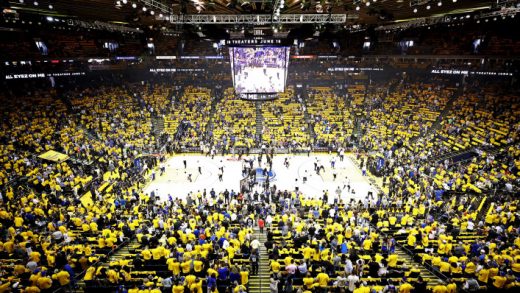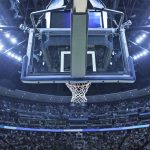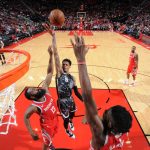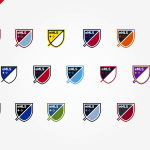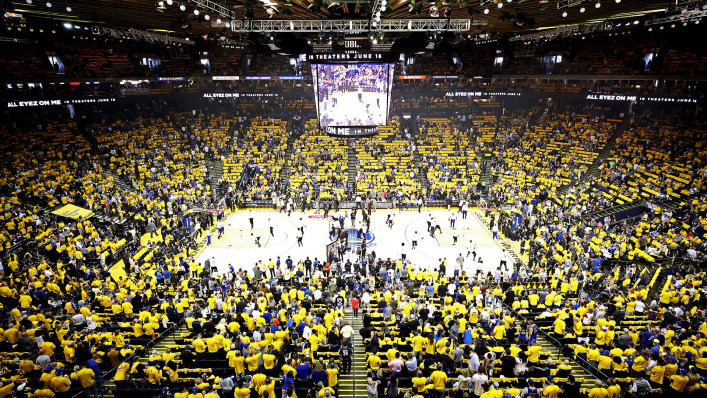How The NBA Became The World’s Most Tech-Savvy Sports League
Inside a raucous Oracle Arena in Oakland last Thursday, with Rihanna, Jay-Z, and Kevin Hart sitting courtside for Game 1 of the NBA Finals, Golden State Warriors superstar Stephen Curry faked out LeBron James and hit a wide-open 3-pointer. Moments later, my phone buzzed with the arrival of a video courtesy of the Warriors’ Messenger bot.
Accompanied by the caption “Steph #SPLASH,” the 9-second clip showed the two-time-reigning NBA MVP burying the trey and giving the Warriors a 21-point lead over the Cleveland Cavaliers in the third quarter of a game they would eventually win by 22, putting them on the path to the 3-0 series lead they currently enjoy. If they win tonight’s Game 4 in Cleveland, they will become the first team in NBA history to go 16-0 in the playoffs and take home their second title in three years.
Even the most casual sports fan has seen countless highlights over the years, but what was notable about this one was that I received it mere seconds after Curry’s shot swished through the net. And not a single human being had been involved in pushing that notification to my phone.
At least not in the time between Curry’s made bucket and the message hitting my phone, that is. Its arrival was due to a highly automated clip-generation tool employed by the NBA and many of its teams to almost instantaneously build highlight packages.
The Israeli startup behind that tool, WSC Sports Technologies, is a model beneficiary of an ecosystem the NBA has built over the last few years to discover and evaluate new technology, and which revolves around ongoing informal communications between the league’s home offices in New York City’s bustling midtown and the posh corridors of Silicon Valley’s venture capital community.
It’s an ecosystem that has been built to make the NBA especially nimble and responsive to the needs of the league, its teams, and its many partners.
The NFL has its own venture fund, and Major League Baseball teams like the Los Angeles Dodgers run tech incubators, says Courtney Brunious, the associate director of the USC Sports Institute, but the NBA may well have have the edge when it comes to technology.
The “NBA has been one of the most forward-looking leagues in terms of technology, in terms of being on top of new innovations in tech,” says Brunious. “As a whole, I would say the NBA is probably the most tech-savvy amongst the leagues.”
The NBA’s leadership in that area, and its impetus to move quickly in adopting new technologies, is due in part to the fact that some of its newest team ownership groups are led by venture capitalists (the Warriors and the Boston Celtics) or those who’ve run tech companies (the Cavaliers, the Dallas Mavericks, the Sacramento Kings, the Los Angeles Clippers, the Memphis Grizzlies, and the Portland Trailblazers). Still, the efforts began in earnest when Adam Silver became league commissioner in 2014.
For his part, Silver lauds the league’s relationships in Silicon Valley and credits work done by the Warriors to help build bridges to the largest companies in the tech community there, who have been enthralled by the team’s recent success, and the NBA.
The league has worked with many of those tech giants, such as Facebook, for some time. But when it comes to discovering and evaluating startups, Silver credits Melissa Brenner, the NBA’s senior vice president of digital media. “She seems to know all of those small companies,” Silver said during his annual pre-Game 1 State-of-the-NBA press conference. “She finds them, she meets with them, and then she brings [in] the really interesting ones.”

Minutes earlier, in fact, with members of the Cavaliers warming up a few feet away, I’d been sitting with Brenner discussing the ecosystem she built to keep the NBA at the forefront of technology.
“As it relates to new technology…we have a pretty tight process where we want to have a team in place that could vet new companies, because you never know what company’s going to walk in the door that will have a transformational effect on our fan experience,” Brenner said, almost shouting over the oppressive din that comes with putting on a major pro sports championship. “So whether it’s virtual reality, augmented reality, or a bot, or AI, there’s so many exciting pieces of technology out there from all over the world.”
The process is multi-faceted, but also pretty simple. The league puts on networking events at things like the All-Star game in order to meet VCs and promising startups. Individual NBA teams also serve as a front line for feeding the league interesting companies. Then Brenner and her team stay in touch with all of those people to make sure they keep abreast of the latest sports-related technology, as well as to ask for potential solutions to challenges the NBA has decided it has to solve. And internally, experts on everything from business development to strategy to social media to finance to engineering vet possible new tech partners.

Instant Highlights
WSC is a good example of a startup whose nascent products were discovered, and then adopted by the NBA, thanks to the process Brenner has installed.
“We took on the philosophy that we should meet with everyone [who pitches the league], as ambitious and crazy as that sounds,” says Bob Carney, the NBA’s vice president of emerging media, the primary reason being “to make sure we’re educated in the space….We’ve always thought it’s critical to be as educated as possible on what’s happening in the industry.”
As Carney recalls it, WSC, founded by several veterans of Israel’s military who had been building basketball scouting software for coaches, first came calling—thanks to an introduction from an industry consultant—in 2014.
“They had an incredibly poorly designed website and poorly designed marketing materials, and it was one of those intros you get where I’m not sure I have the time,” he says. “But going back to that philosophy [of meeting with everyone] because you never know, I ended up taking the meeting.”
WSC was pitching automatic highlight generation, something Carney had heard before. But it also offered something special—the ability to automatically determine the start and end time of every single play that happens in every single game, in close to real time. That meant its technology was capable of producing highlight packages almost immediately, and with zero human intervention.
Impressed by WSC’s pitch, he gave them a tryout, providing them some games where the downside of failure was low: NBA Developmental League, or D-League, contests. Quickly, WSC returned a highlight package for every player in every game.
“That was the holy s–t moment,” Carney says. “All of a sudden, we had an immense amount of content that would have taken several people and many, many hours…to create….That was the first moment where we were truly wowed and began to understand where this could truly go.”
Late that season, in the spring of 2014, the NBA extended the pilot, letting WSC loose on the remainder of the D-League season. The result was large amounts of auto-generated highlight packages that WSC was also able to automatically distribute on YouTube, as well as through the D-League’s social channels and app.
The NBA had struck gold, and began to utilize the system for its own teams. As a league with a global fan base, it has countless social channels, apps, and websites, all of which have their own owners inside the league offices and around the world. Now, Carney says, each of those people could tell the NBA what they wanted to feature in order to best serve their audiences, and WSC’s tools would be able to generate that content almost in real time after each night’s games.
Previously, when producing highlights manually, the NBA would never have made a nightly package for a middle-of-the-road player like the Australian Matthew Dellavedova, a former Cavaliers backup now with the Milwaukee Bucks. But with over 10 Australian players in the NBA, there’s a hunger from Down Under for regular highlights, and now WSC’s tools make it possible to give the people what they want, including all the Dellavedova highlights they could ever handle.
“Imagine that, but applied to every single digital distribution point we control in the world, of which there are many,” Carney says, “and you start to see how powerful a platform like this can be for an organization that’s trying to feed a global audience.”
WSC’s system allows its users to input any number of rules, looking for all the key stats—players’ made and missed field goals, assists, blocks, steals, and so on. The NBA knew that things like Curry 3-pointers were a big hit, so it could set up a rule that any time the so-called Babyfaced Assassin hit three of them in the first quarter, the tool could spit out a highlight package.
Or anytime anyone in the league hit six treys in a game, it could do the same. No one knew where exciting performances were going to come from, but the beauty of the platform was that rules could be set up for something like any player burying six 3s.
“By the time a person would actually know” a player had hit six 3-pointers, Carney says, “this system would have already created a highlights package.”
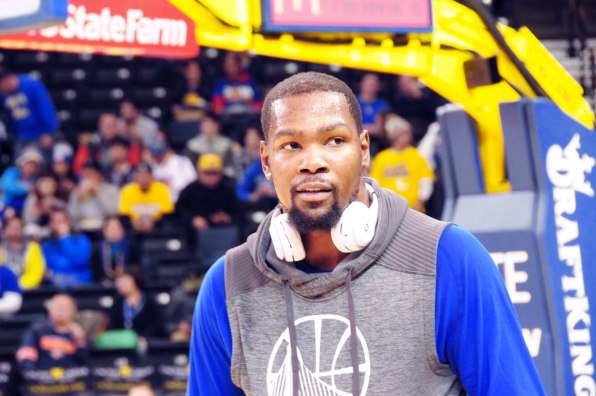
Working With VCs
Some of the most important contributors to the NBA’s tech-evaluation ecosystem are the informal network of venture capitalists that Brenner has cultivated over the last few years, a group of sports-loving investors who are on the lookout for anything that might be useful to a global sports media and events company like the NBA.
The relationships with the VC community have also been built to make it easy for the NBA to reach out to the Silicon Valley types for suggestions when there’s a specific business problem to solve. An example is translation services technology, a must-have for a league with fans all around the world, and 25% of its players from abroad. Currently, the NBA translates information into seven languages, but it knows that if it expands that number, it could potentially reach more fans.
An expansion like that has to be economically scalable, though, so Brenner recently put the word out to her VC partners that the NBA was looking for new translation or transcription technology.
“We said this is an area we’re concerned about [and] do you have any ideas on tech companies that do this really well,” Brenner recalls. “There’s companies that do it, but you also want someone that is nimble, and scalable, and economical, and [the VCs] start to tell you the story of where their investments [in the area] are, or what they’ve heard about.”
Her team is currently in the middle of vetting some of the recommendations that came back.
Sometimes, the advice is more general, such as two years ago when one VC—Brenner can’t remember which one—recommended that the league should get heavily involved in bots, given that they can quickly and easily push valuable information to fans about their favorite teams or players. Get enough fans engaged that way, the argument went, and soon you’ll see more ticket sales and more people subscribing to the NBA’s League Pass service, which allows for unlimited viewing of out-of-market games.
That advice led the NBA to begin working directly with Facebook on development of its Messenger bots.
“They have been very proactive in developing select relationships,” says Jeff Jordan, a partner at the A-list VC firm, and NBA partner, Andreessen Horowitz. “There’s a short list of VCs who clearly love athletics….The NBA establishes relationships with people who have that interest [and] we see deals that are of interest to us. They’re getting into the deal flow by having the relationships.”
Jordan, who has also advised individual players interested in tech investing like the Warriors’ Andre Iguodala, recalls suggesting the NBA look into several different technologies geared toward new ways to present sports on TV. One was a rotating 3D technology that ultimately was used during the broadcast of the Winter Olympics, he says.
In the meantime, there’s also a two-way street that runs between the league and its teams.
The Warriors’ Messenger bot, which incorporates WSC’s highlight-creation tool, is an example of that. But the give-and-take also involves new technologies, either coming from the teams to the NBA, or vice versa.
“If there’s a tech we want to try, it’s not like we’re scared to bring it to [the NBA], says Daniel Brusilovsky, the Warriors’ digital initiatives lead. “We’re encouraged. Friends at other leagues are jealous, because of how much the NBA empowers teams to be innovative.”
Brusilovsky says that Warriors co-owner, Hollywood mogul Peter Guber, had raised the idea that though fans sitting in the first few rows at games can hear the players and referees talking and many other game sounds, those behind them miss out on that part of the experience. In contrast, Guber notes, at the opera or symphony the acoustics are designed so that everyone can hear everything. He wanted the team to look into sound amplification technology.
For the last two years, the team has been testing various approaches to this, and “when we told the NBA, they said ‘this is amazing, let us know how we can help test [it],’” Brusilovsky explains. “They saw this as a great idea for the league….I think they’re looking at this as a great enhancement to the fan experience and something the league should be looking at.”
Kirk Lacob, the Warriors’ assistant general manager, points to another type of technology used by NBA teams that the league later adopted–cameras that capture 3D data that’s then used to generate analytical data.
A few teams had been using a system called SportVU that’s able to track the movement of all players in real time. But the NBA felt that unless every team was using the technology, there wouldn’t be a level playing field, so the league agreed to pay for its implementation by all 30 teams, Lacob says. And more recently, he adds, the league decided to switch over to a new system, from Second Spectrum, that includes cameras and data analysis.
An example of a more fan-facing technology moving from the teams to the league is that of YinzCam, a startup that had developed mobile apps for the Phoenix Suns.
Carney says he met YinzCam through the Suns and quickly saw that the startup was uniquely positioned to build the kind of high-quality apps for multiple mobile platforms, and a lot of them, that the NBA requires of its teams. Today, thanks to that introduction, the NBA is a part owner of the company, and it has built about 100 apps for the league and 24 of its teams.
“We always say, the way we’re structured,” Carney says, “we view the 30 teams plus the league office, as one community that is always vetting technology partners.”
For her part, Brenner thinks the NBA should be open to new ideas, no matter where they come from–teams, consultants, VCs, or directly from companies.
“You think about the last couple of huge companies that have come from [Silicon] Valley,” Brenner says. “Mark Zuckerberg created his in his dorm room. Sergey [Brin] and Larry [Page] did it in their garage. So how are you set up to be open to hear from interesting entrepreneurs–and we see a lot of them, because so many people love the NBA and want to be involved in some way. So how do you have a process where you’re open to see all these new ideas as they come in?”
By building an ecosystem that involves VCs, teams, startups, and others, the league has become nimble and able to quickly adopt new technologies.
Inside a raucous Oracle Arena in Oakland last Thursday, with Rihanna, Jay-Z, and Kevin Hart sitting courtside for Game 1 of the NBA Finals, Golden State Warriors superstar Stephen Curry faked out LeBron James and hit a wide-open 3-pointer. Moments later, my phone buzzed with the arrival of a video courtesy of the Warriors’ Messenger bot.
Fast Company , Read Full Story
(101)

